full article:
Introduction
Mental illness contributed to almost 11% of the total world disease burden in 1990 and is predicted to reach 15% by 20201. In Australia, nearly 20% of individuals suffer from a mental illness such as anxiety, depression or substance abuse, and almost one half of these are affected long term2,3. Moreover, mental disorders are the leading cause of years of life lost due to chronic disability4. Psychosocial determinants of health such as socioeconomic position, social networks and support, discrimination, stressful events and a sense of control (in work and life generally) are now understood to play an important part in disease development and prognosis5-7. Psychosocial determinants can mediate the effects of social structural factors on individual health outcomes or, in turn, are modified by the social structures and contexts in which they exist8.
Rural and remote Australians experience significant inequalities in health for many health indicators such as suicide, circulatory diseases, respiratory diseases, diabetes, some cancers, injuries and access to adequate health care9. It is generally perceived that people from rural and remote communities are at heightened risk of mental illness because many of the psychosocial determinants of health are magnified by factors related to remoteness, such as isolation, economic restructuring and unpredictable ecological conditions10. Previously we have shown no spatial variation in prevalence rates of mental illness across South Australia, and the overall age-sex standardised prevalence of depression, anxiety and stress-related problems was 12.7% (95% CI: 11.4-14.0)11. However, it is unknown whether remoteness per se (as distinct from other aspects of areas) is an important risk factor for mental illness.
The aim of this study was to determine if remoteness per se was associated with mental illness, by examining the relationship between stressful life events and mental illness, when controlled for the potential confounding effects of remoteness.
Methods
Survey design and sample selection
Data were obtained from the South Australian component of the Western Australia, Northern Territory and South Australia collaborative 'Health and Wellbeing' (WANTS), Computer Assisted Telephone Interview (CATI) survey, conducted during October and November 2000, by the former Centre for Population Studies in Epidemiology, Department of Human Services, South Australia, Australia12. CATI is a telephone monitoring system designed to provide high quality data and is an efficient means of monitoring self-reported aspects of population health, particularly in rural and remote areas13.
The survey was administered to South Australian residents via a 15 min telephone interview. All households with a telephone number listed in the latest version of the Australian Electronic White Pages were eligible for inclusion and, in each selected household, the last person to have a birthday was selected. The survey used a stratified, random sampling method where separate random samples were drawn from each of three geographic regions (metropolitan, rural and remote) and oversampling was undertaken in non-metropolitan areas. The aims, methods and initial findings of the survey have been reported elsewhere12.
Survey measures
Mental health: Self-reported, but medically confirmed, mental illness was derived from the question, 'In the last 12 months, have you been told by a doctor that you have anxiety, depression, a stress-related problem, any other mental health problem or receiving treatment for this?'
Geographical dispersion: Remoteness was determined using the Accessibility and Remoteness Index of Australia (ARIA)14. ARIA is a geographical index that defines remoteness as accessibility to 201 service centres across Australia based on road distances. Remoteness values for 11 338 populated localities are derived from the road distance one has to travel to reach service centres in four different categories based on population size (A:>250 000 people; B:48 000-249 999; C:18 000-47 999; D:5000-17 999), and a weighting factor is applied for islands. Using geographical information system capabilities, distances for each populated locality are converted to a continuous variable with values that range from zero for high accessibility to 12 for extreme remoteness. ARIA values were then grouped into five aggregate categories using 'natural breaks' in the zero to 12 continuous variables, ('highly accessible' [0-1.84]; 'accessible' [1.84-3.51]; 'moderately accessible' [3.51-5.80]; 'remote' [5.80-9.08]; 'very remote' [9.08-12.0]). ARIA was developed so that the locational disadvantage of a place can be assessed as distinct from other aspects of areas (such as socioeconomic status and population size factors), to increase the scope for examining the relationship between remoteness and other aspects. Data for remote and very remote categories were combined to produce a sufficient sample size.
Psychosocial determinants: Socio-demographic data and lifestyle behaviours Respondents were asked their age, sex, marital status, country of birth, type of work they had done for most of their lives, employment status, educational attainment, total annual combined household income, current money situation ('spend more money than get, have just enough to get through to next pay day, have some left over each week, can save a bit every now and then or can save a lot') or whether they were in receipt of a pension or benefit from Centrelink, the Department of Veterans Affairs or overseas.
Data were obtained on alcohol consumption ('non drinker/no risk, low risk, intermediate, very high risk'), smoking status ('non-smoker, ex-smoker and smoker'), height (in metres) and weight (in kilograms). Body mass index was derived from self-reported height and weight, scored (weight (kgs)/height [m]2 and classified into four categories; underweight (less than 20), normal weight (20-25), overweight (>25-30) and obese (>30), according to current international criteria15. The presence or absence of a physical health condition was determined using the SF-12 Physical Component Summary (PCS). The SF-12 was scored as specified in the SF-12 scoring manual16. The scores range from zero to 100, and a PCS score of 50 or less determines a physical condition17. Nutritional status was determined by respondent fruit and vegetable consumption and classified according to nationally recommended cut offs (≤ 1, 2-3 and > 3 serves daily), respectively18. Measures of physical activity included self-reported low (days walked for at least 10 min at a time), moderate (days engaged in brisk walking, bicycling, vacuuming, gardening or anything else that caused increased breathing or heart rate) or vigorous exercise (days engaged in activities designed to increase muscle strength or tone, such as lifting weights, pull-ups or push-ups).
Perceived control of life events Respondents were asked how much of the time during the past four weeks they felt a lack of control with: life in general, their financial situation, personal life, job security, work life (paid or voluntary) or health. Similar to questions included in previous Australian health surveys, responses were recorded on a 5-point scale ranging from one, never to five, always19.
Stressful life events Respondents were asked whether in the past 12 months they had: experienced the death of someone close, a new job, moved house, a marriage/relationship break-down, robbery or burglary, serious illness, discrimination, serious injury, unplanned loss of job, family or domestic violence or other major event. Selected major stressful event questions were derived from a previous South Australian mental health survey20.
Statistical analysis
Data were weighted by geographic region (metropolitan, rural and remote) age, sex and probability of selection in the household using the ABS 1999 census total ERP of adults aged 18 years or more21. As each region involved a discrete sample, these were weighted separately. The study had 92% power (at the 5% level) to detect a 50% difference in prevalence of self-reported mental illness between remote/very remote areas and elsewhere.
Data were analysed using SPSS vers 12.01 (SPSS Inc; Chicago IL, USA) and Stata vers 8 (StataCorp; College station, TX, USA). Bi-variate analyses (using univariate logistic regression models) were undertaken initially to examine associations between ARIA, socio-demographic characteristics, stressful life events, perceived control of life events and lifestyle behaviours, and mental illness. Next, a multivariate logistic model was developed (and included all variables with a p-value <0.25 at the bi-variate level) to determine the variables that best predicted mental illness. The model was fitted using backward stepwise elimination of non-significant variables, based on log likelihood ratio tests and a p-value of 0.05. Logistic regression analysis generates a coefficient for each variable that is equal to the natural logarithms of the odds ratio for predictors22. Odds ratios for categorical variables represent the odds of having a self-reported mental illness relative to the reference category. Receiver-Operator-Characteristic (ROC) curve statistics and model goodness-of-fit tests were conducted to examine the performance of the model in predicting presence or absence of disease.
Finally, a series of multivariate logistic regression models was developed (and included all variables used in the previous model) to examine the relationship between stressful life events and mental illness, while adjusting for the sequential inclusion of potential confounders (joint stressful life events, ARIA, perceived control of an event and lifestyle behaviours). Crude and adjusted odds ratios are reported, together with 95% confidence intervals.
Results
Sample population
Of 3989 eligible respondents, 1446 proved ineligible due to no contact after six attempts (n = 542), refusals (n = 737), being incapacitated (n = 98), unable to speak English, Italian, Greek, Croatian, Chinese or Vietnamese (n = 41), hearing impaired (n = 14) or because of terminated interviews (n = 12). In all, 2545 respondents participated in the survey. A response rate of 64% is in keeping with surveys of this type. Aboriginal people represented 1% of the sample which is similar to the proportion for Australia as a whole.
Remoteness and mental illness
The unadjusted odds of mental illness were statistically significantly lower among residents of accessible and remote/very remote areas, compared with highly accessible areas (OR 0.67, 95% CI 0.50-0.91; and OR 0.73, 0.54-1.00) (Table 1).
Table 1: Crude odds ratios and 95% confidence intervals for likelihood of mental illness by ARIA and socio-demographic factors
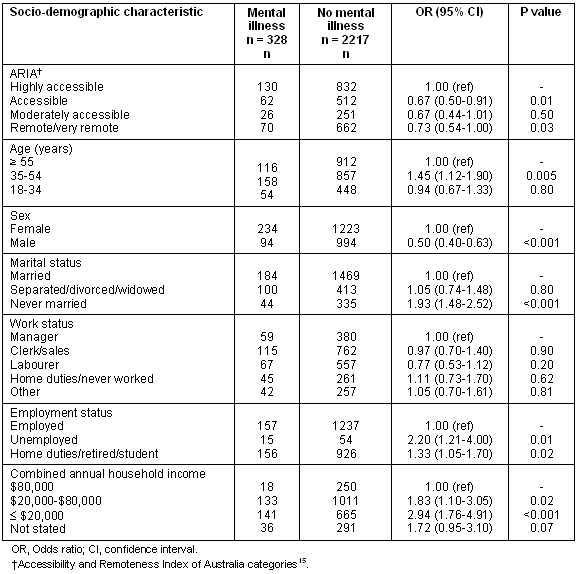
The odds of mental illness did not vary by ARIA and were no longer significantly associated with mental illness after adjusting for the effects of stressful life events, perceived control of life events, socio-demographic characteristics and lifestyle behaviors (highly accessible [reference category]; accessible OR 0.90, 95% CI 0.60-1.31; moderately accessible OR 0.80, 95% CI 0.45-1.43; remote/very remote OR 0.70, 95% CI 0.44-1.03) (Table 2). The ROC curve statistic indicated that the final set of variables correctly predicted the presence of mental illness in 80% of cases (0.8030) and the Hosmer-Lemeshow goodness of fit test indicated a good fitting model (c2 5.67 (df8) [degrees of freedom], p = 0.6847).
Table 2: Adjusted odds ratios and 95% confidence intervals for best predictors of mental illness
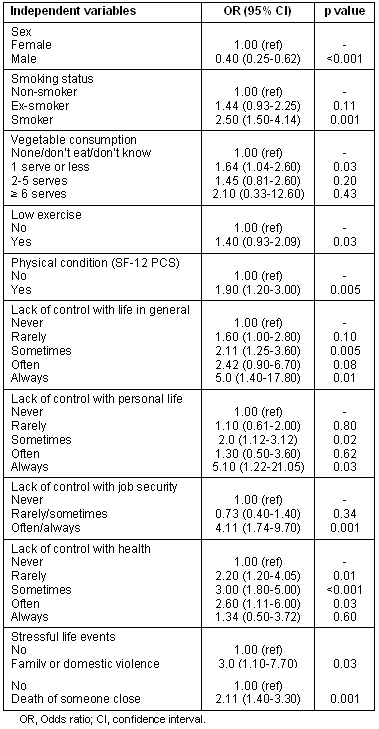
Psychosocial determinants and mental illness
Socio-demographic characteristics and lifestyle behaviours: Increased odds of mental illness was associated with being in mid-age; female; never married; the unemployed, home duties, retirement or a student; and on a low to middle income (Table 1). Being a smoker (OR 2.10, 95% CI 1.53-2.81), having a risk level of alcohol (low risk; OR 1.40, 95% CI 1.10-1.77; intermediate to very high risk; OR 2.00, 95% CI 1.20-3.20) being obese (OR 1.50, 95% CI 1.10-2.01) or undertaking vigorous exercise (OR 1.50, 95% CI 1.20-1.90) was also associated with mental illness (Table 3). Respondents who reported a physical condition experienced a greater than two-fold increased risk of mental illness (OR 2.60, 95% CI 1.80-3.77).
Table 3: Crude odds ratios and 95% confidence intervals for likelihood of mental illness by lifestyle behaviours
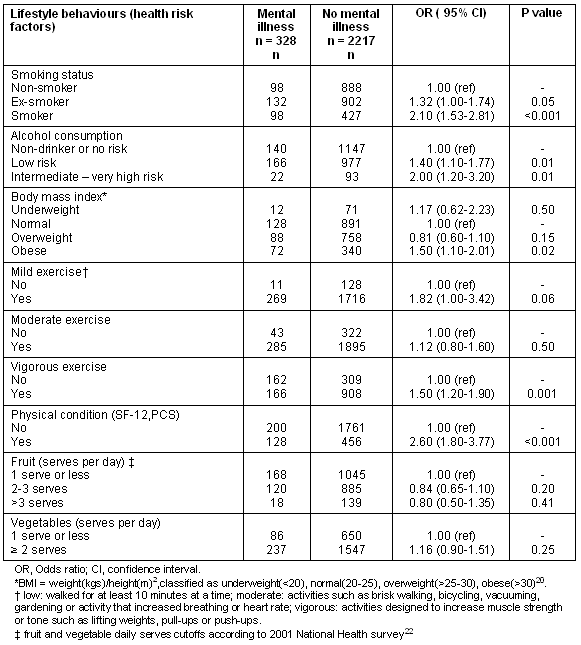
Perceived control of life events: There was a strong inverse association between perceived control of life event variables and mental illness (score test for trend of odds, c2 <0.001 for all domains), particularly for control with life in general, personal life and health (Table 4).
Table 4: Crude odds ratios and 95% confidence intervals for likelihood of mental illness by perceived control of life events in the previous 4 weeks
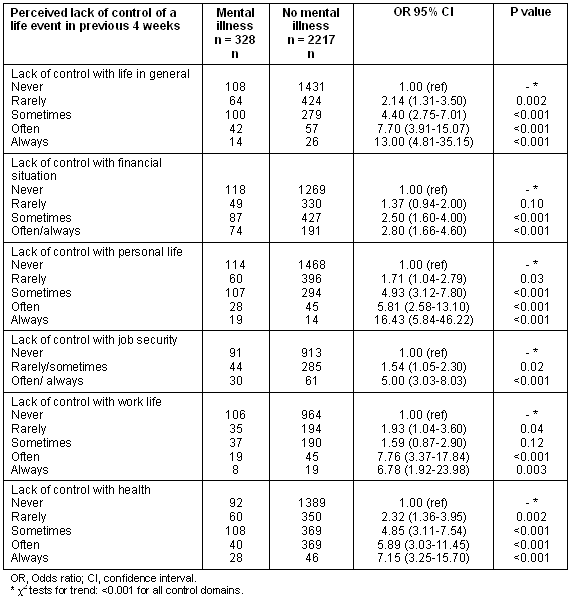
Stressful life events: Six of 11 stressful life event domains were significantly associated with the likelihood of mental illness at the crude level; family/domestic violence (OR 7.25, 95% CI 4.15-12.65); death of someone close (OR 1.71, 95% CI 1.32-2.22); discrimination (OR 4.80, 95% CI 3.10-7.44); marriage/ relationship breakdown (OR 4.75, 95% CI 3.30-6.90), serious illness (OR 3.53, 95% CI 2.51-5.00); or other major event (OR 2.04, 95% CI 1.51-2.80) (Table 5). Controlling for the joint affects of stressful life events, resulted in overall weaker associations between stressful life events and mental illness (Table 5, Model 0). Of particular note, these values did not change after adjusting for the effects of ARIA (Table 5, Model 1).
Table 5: Associations between stressful life events and mental illness; crude odds and adjusted for joint stressful life events; ARIA; perceived control of life events; socio-demographic characteristics and lifestyle behaviours
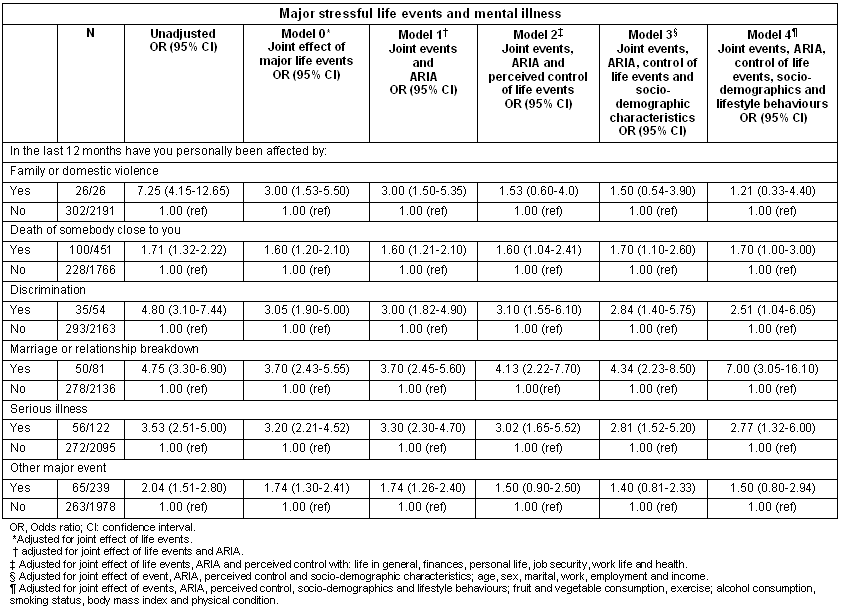
Discussion
Our findings demonstrate that remoteness per se is not an independent risk factor for mental illness.
Despite current perceptions that broader psychological determinants of mental illness are magnified by additional stressors related to remoteness and isolation, we found that remoteness as determined by ARIA had little effect on psychosocial/mental illness associations. Psychosocial determinants such as stressful life events, perceived control of life events, socio-demographic characteristics and lifestyle behaviours were more important predictors of mental illness. It is important to stress that in previous work we have shown that the prevalence of mental illness is not very different across ARIA zones11. Here we have been able to demonstrate through multivariate analysis that remoteness per se is not an independent factor determining mental illness.
Increasingly findings from Australian and international prevalence studies indicate that levels of mental illness are similar everywhere3,11,23-26. However, prevalence is determined by multiple factors and estimates obtained from aggregated data may not be sensitive enough to separate out specific dimensions of locations, such as services and amenities and aspects of the physical and social environment that are important for mental health and wellbeing27,28. Conversely, living in remote locations may be less important than an individual's socio-economic position, or dealing with the stress of government bureaucracy and regulation, financial worries and family problems29,30. In an attempt to unpack the factors guiding prevalence rates of mental illness, our study found that remoteness (as determined by distance to healthcare services) was not an important independent determinant.
Many of the associations between stressful life events and mental illness were explained, wholly or in part, by other stressful life events, perceived control of life events, socio-demographic characteristics and lifestyle behaviors. In common with previous research, our findings indicate that perceptions of control play an important role in reducing stressful life events30,31. The link between socio-demographic characteristics and lifestyle behaviors and health are well established for important chronic diseases such as diabetes and circulatory diseases, and our results indicate that these factors also contribute to the stressful life event/mental illness associations examined here.
Our study has some important limitations. As with all observational designs, we were not able to infer causation or establish temporal relationships. While combined measures of mental illness have been shown to produce similar estimates to those derived from well validated scales, it is possible that combined measures may mask independent relationships11. Our data were based on self-report which raises the possibility of contamination of the associations studied. Verbal reports, based on medical advice have good sensitivity and specificity for screening for depression in general practice32 however, self-reported measures are reliant on voluntary self-disclosure and a person's recognition of the need for appropriate psychological assessment33. Additionally, our results are based on data obtained prior to the introduction of the Better Outcomes in Mental Health initiative (and associated GP training programs) which may now lead to greater recognition of mental illness by doctors than at the time of the current study34. We also acknowledge that self-reported, medically confirmed, mental illness measures will not capture individuals in the community with undiagnosed or untreated mental illness.
A serious shortage of trained mental health care personnel (eg psychiatrists and mental health care workers)35, particularly in South Australian country areas, may have resulted in fewer people accessing doctors and unable to confirm a medical diagnosis of mental illness, or indeed, encouraged people to migrate to a larger range and specialisation of health services in major regional or urban centres, resulting in differential misclassification and bias towards the null. Thus, while a geographical index can determine a person's remoteness from their closest service centre, this does not mean that the services are adequate or that they are efficiently accessed by people. In terms of mental illness, this latter point is perhaps the most important and should be a priority for further research.
Our study has shown that remoteness per se was not associated with mental illness. Psychosocial factors such as stressful life events, perceived control, socio-demographic status and lifestyle behaviors were more important determinants of mental illness. There is now evidence to suggest that many psychosocial determinants may be beyond an individuals control and shaped by broader contextual factors such as macroeconomic forces, political decisions, legal welfare structures and patterns of migration, history and culture36. In Australia, the shift in government policy away from spatial equity to economic efficiency over the last few decades, has resulted in dramatic economic, social and demographic change, particularly in rural areas, where the decline of commercial and public services (including health), significant emigration and loss of employment has seriously eroded local infrastructures in many rural communities37. More resources are needed to address the high rates of mental illness in Australia, with particular attention to rural contexts.
Acknowledgements
This work has been supported, in part, by grants from 'beyond blue' the National Depression Initiative, and the Australian Government Department of Health and Aged Care, Australia.
References
1. Murray CJL, Lopez AD (Eds). Global burden of disease and injury series, volume 1: a comprehensive assessment of mortality and disability from diseases, injuries and risk factors in 1990 and projected to 2020. Cambridge, MA: Harvard University Press, 1996.
2. Australian Institute of Health and Welfare and Commonwealth Department of Health and Family Services. First report on national health priority areas 1996. (AIHW catalogue no. PHE 1). Canberra: AIHW, 1997. Available: www.aihw.gov.au/publications/health/frnhpa96/ (Accessed October 2004).
3. Australian Bureau of Statistics. Mental health and wellbeing: profile of adults, Australia, 1997. (ABS Catalogue no. 4326.0). Canberra: ABS, 1997.
4. Mathers C, Vos TCS. The burden of disease and injury in Australia. Canberra: Australian Institute of Health and Welfare, 1999; 1-171.
5. Commonwealth Department of Health and Aged Care. Promotion, prevention and early intervention for mental health - a monograph. Canberra, ACT: Mental Health and Special Programs Branch, 2000.
6. Wilkinson RG, Marmot M (Eds). The social determinants of health: the solid facts. 2nd edition. Geneva: WHO, 2003. Available: www.who.dk/document/e81384.pdf. (Accessed: 12 April 2005).
7. Marmot M. Multilevel approaches to understanding social determinants. In: L Berkman, I Kawachi (Eds). Social epidemiology. New York: Oxford University Press, 2000; 349-367.
8. Martikainen P, Bartley M, Lahelma E. Psychosocial determinants of health in social epidemiology. International Journal of Epidemiology 2002; 31: 1091-1093.
9. Australian Institute of Health and Welfare. Rural, regional and remote health: a study on mortality (summary of findings). (AIHW cat. no. PHE 53). Canberra: AIHW, 2003. Available: www.aihw.gov.au (Accessed 10 January 2004).
10. Commonwealth Department of Health and Aged Care. National action plan for promotion, prevention and early intervention for mental health. Canberra: Mental Health and Special Programs Branch, Commonwealth Department of Health and Aged Care, 2000.
11. Eckert KA, Taylor AW, Wilkinson DD, Tucker GR. How does mental health status relate to accessibility and remoteness? Medical Journal of Australia 2004; 181: 540-543.
12. Taylor A, Daly A, d'Espaignet E et al. Collaborative Health and Wellbeing CATI Survey of adults living in Western Australia, Northern Territory and South Australia: Report 1: Summary of results by State/Territory. Adelaide: South Australian Department of Human Services, 2002.
13. Starr G, Dal Grande E, Taylor A, Wilson DH. Reliability of self-reported behavioural health risk factors in a South Australian telephone survey. Australian and New Zealand Journal of Public Health 1999; 23: 528-530.
14. Commonwealth Department of Health and Aged Care. Measuring remoteness: Accessibility/Remoteness Index of Australia (ARIA). Occasional Papers: New Series No. 6. Canberra, ACT: Commonwealth Department of Health and Aged Care, 1999.
15. WHO. Obesity: preventing and managing the global epidemic. Report of a WHO consultancy on obesity. Geneva: WHO, 1997.
16. Ware J. SF-36 Physical and mental health summary scales: a user's manual. Boston, MA: The Health Institute, New England Medical Centre, 1995; 11.
17. Ware J. How to score the SF-12 Physical and Mental Summary Scales. Boston, MA: The Health Institute, New England Medical Centre, 1995.
18. Australian Bureau of Statistics. National Health Survey: summary of results, Australia. (Catalogue No. 4364.0). Canberra: ABS, 2002.
19. Department of Health and Human Services (Tasmania). Healthy community survey. Hobart, Tas: Department of Health and Human Services, 1998.
20. Taylor A, Dal Grande E, Parsons J. Mental health status of South Australians. Adelaide, SA: Behavioural Epidemiology Unit, Epidemiology Branch, Public and Environmental Health Services, South Australian Health Commission, 1997.
21. Australian Bureau of Statistics. Population by age and sex, South Australia. Canberra: ABS, 1999.
22. Hosmer DW, Lemeshow S. Applied logistic regression, 2nd edn. New York: John Wiley & Sons, 2000; 105.
23. McLennan W. Mental Health and wellbeing: profile of adults, Australia. (Cat no. 4326.0). Canberra: Australian Bureau of Statistics, 1997.
24. Murray G, Judd F, Jackson H et al. Rurality and mental health: the role of accessibility. Australian and New Zealand Journal of Psychiatry 2004; 38: 629-634.
25. Kessler RC, McGonagle KA, Zhao S et al. Lifetime and 12-month prevalence of DSM-III-R psychiatric disorders in the US: Results from the national comorbidity survey. Archives of General Psychiatry 1994; 51: 8-19.
26. Kessler RC, Chui WT, Demler O, Walters MS. Prevalence, severity and comorbidity of 12-month DSM-IV disorders in the national comorbidity survey replication. Archives of General Psychiatry 2005; 62: 617-627.
27. MacIntyre S, Ellaway A. Ecological approaches: rediscovering the role of the physical and social environment. In: L Berkman, I Kawachi (Eds). Social Epidemiology. Oxford University Press, 2000; 332-348.
28. Judd FK, Jackson HJ, Komiti A et al. High prevalence disorders in urban and rural communities. Australian and New Zealand Journal of Psychiatry 2002; 36: 104-113.
29. Lobley M, Johnson G, Reed M et al. Rural stress review. Report to RSIN. Exeter: Centre for Rural Research, University of Exeter, 2004. Available: http://www.centres.ex.ac.uk/crr/pdf1/reports1/StressReviewFinalReport.pdf (Accessed: 12 June 2005).
30. Mahler HIM, Kulik JA. Preference for health care involvement, perceived control and surgical recovery: A prospective study. Social Science Medicine 1990; 31: 743-751.
31. Morris J, Royle GT. Offering patients a choice of surgery for early breast cancer: a reduction in anxiety and depression in patients and their husbands. Social Science Medicine 1988; 26: 583-585.
32. Arroll B, Khin N, Kerse N. Screening for depression in primary care with two verbally asked questions: cross sectional study. BMJ 2003; 327: 1144-1146.
33. Hickie IB, Davenport TA, Ricci CS. Screening for depression in general practice and related medical settings. Medical Journal of Australia 2002; 177: S111-S116.
34. Hickie IB, Pirkis JE, Blashki GA et al. General practitioners' response to depression and anxiety in the Australian community: a preliminary analysis. Medical Journal of Australia 2004; 181: S15-S20.
35. National Rural Health Alliance Inc. Rural mental health crying out for more support. (Online) 2005. Available: http://www.ruralhealth.org.au/nrhapublic/Index.cfm?Category=MediaReleases&Year=2005 (Accessed 7 May 2006).
36. Kawachi I, Berkman L (eds). Neighborhoods and health. New York: Oxford University Press, 2003; 1-19.
37. Larson A. Contemporary rural Australian society. In: Wilkinson D, Blue I (Eds). The New Rural Health. Melbourne: Oxford University Press, 2002; 3-11.




